2016
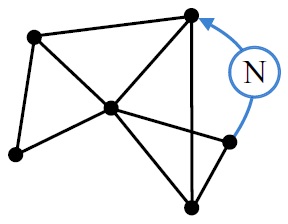
Decoherence-enhanced performance of quantum walks applied to graph isomorphism testing
M. Bruderer and M.B. Plenio,
Phys. Rev. A 94, 062317 (2016)
DOI:https://doi.org/10.1103/PhysRevA.94.062317
Are two graphs – the mathematical term for a network of links and nodes – the same, even if they look different at first glance? This supposedly simple problem has been intriguing researchers for decades and crops up in numerous applications. While many ways for distinguishing graphs have been suggested we took an unusual approach:
Imagine there is a particle moving on the graph, that is to say the particle can hop between nodes whenever they are linked. Now one would expect that the motion of the particle depends on the overall shape of the graph. In our paper we show that indeed if the particle is observed for a long time, even if only between two nodes, it is possible to identify the underlying graph. To our surprise we found that this approach works best neither for classical particles nor for particles following the laws of quantum mechanics, but somewhere on the border between the classical and quantum world. This contradicts the established paradigm that quantum is always better and it seems that a good mix between quantum and classical is the best choice for solving some mathematical problems.
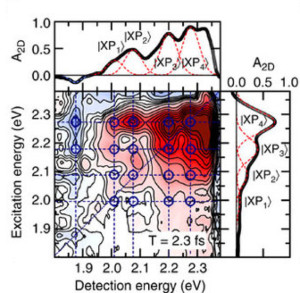
Tracking the coherent generation of polaron pairs in conjugated polymers – A. De Sio, F. Troiani, J. Rehault, E. Sommer, J. Lim, S.F. Huelga, M.B. Plenio, M. Maiuri, G. Cerullo, E. Molinari, and Ch. Lienau,
Nature Comm.7, 13742 (2016)|ArXiv
licensed under CC BY 4.0
Organic solar cells have attracted considerable interest in recent years due to their potential as efficient and low-cost solar energy converters. For various conjugated polymers in solar cell applications, experimental studies have reported ultrafast charge separation at the interfaces between polymers and fullerenes on a sub-100 fs timescale. Theoretical studies based on time-dependent density functional theory suggested that strong electronic and vibronic couplings of organic photovoltaics may support ultrafast charge separation dynamics. However, the functional relevance of the coherent electronic and vibronic couplings under noise and disorder and their experimental verification remain open questions. In this work, we investigate the polaron pair formation in a reference conjugated polymer for solar cell applications by means of two-dimensional electronic spectroscopy. Here the excitons created by light absorption dissociate into polaron pairs that have been considered as the precursors of free charges. We show that experimentally observed polaron pair formation on a sub-100 fs timescale is governed by coherent electronic and vibronic couplings even in the presence of a high noise level at room temperature and a large energetic disorder of the conjugated polymer. We show that a coherent, vibronic model can reproduce the main features of experimental finding, including vibronic-level structures observed in experiments, shown in the figure, which cannot be accounted by an incoherent model where charge separation is governed by a classical rate equation. Based on model parameters estimated from experimental data, we show that non-equilibrium vibrational motions of the C=C stretch mode of the conjugated polymer underpin ultrafast polaron pair formation and that this mechanism is robust against noise and disorder due to the strong electronic coupling and large Huang-Rhys factors of the present system. Our results suggest the possibility that vibronic coupling, which was shown to play a central role in the excitonic dynamics of natural and artificial light-harvesting systems, also plays an important role in the charge separation dynamics in the organic photovoltaics.
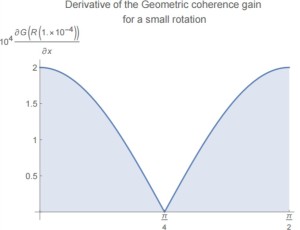
A note on coherence power of N-dimensional unitary operators
M. Garcia-Diaz, D. Egloff, and M.B. Plenio,
Quant. Inf. Comp.16, 1282 (2016)|ArXiv
At the heart of quantum mechanics lies the principle that states can be in a linear superposition even while only being observable in discrete quanta. Recently the notion of how much superposed a state is relative to a given basis has been formalized and named coherence theory. This theory hence allows to compare different states in their degree of superposition. In a similar spirit one might now wonder on how much superposing (and hence not classical) a map is and therefore ask how much coherence it can maximally produce; in other words, one might ask what its coherence power is. In this notes we discuss basic properties of the coherence power and show tools that are useful for calculating the coherence power of maps, explicitly giving a new proof for the two-dimensional unitary case and analysing some instructive examples.
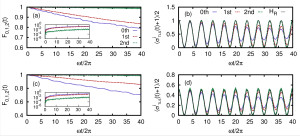
A robust scheme for the implementation of the quantum Rabi model in trapped ions
R. Puebla, J. Casanova, and M.B. Plenio,
New J. Phys. 18, 113039 (2016)|ArXiv
licensed under CC BY 3.0
(Here is the link to the video abstract.)
The maintenance of quantum coherence is a crucial ingredient to exploit the advantages of quantum settings with respect to their classical counterparts. However, experimental imperfections or, simply, the unavoidable presence of noises severely restrict the quantum coherence to a short duration. Hence, a long-time preservation of the quantum coherence is highly desired although its realization constitutes a formidable task. A number of techniques have been proposed to handle different noise scenarios to maintain quantum coherence during a prolonged time. Among them, we focus on the continuous dynamical decoupling technique, which consists in applying continuous drivings that provide a dressed basis in which the noise effects are largely suppressed, if the noise has vanishingly small frequency components close to the frequency splitting of the new dressed basis. Interestingly, this method allows for a concatenated scheme, i.e., introducing additional continuous drivings to handle different sources of noise, as demonstrated in New J. Phys. 14 113023 (2012) for an electron spin of nitrogen vacancy centers in diamond.
More specifically, in our work we analyze the applicability of the continuous dynamical decoupling technique, in its concatenated configuration, to trapped-ion settings. In particular, we illustrate how to realize a noise-resilient and tunable quantum Rabi model with a trapped-ion. The paradigmatic quantum Rabi model describes the interaction between a single two-level system and a bosonic field mode. Note that despite its apparent simplicity, this model shows a rich variety of physics depending on the parameter regime as the transition from Jaynes-Cummings model to deep strong coupling regime, the relativistic Dirac equation or the emergence of a second-order quantum phase transition. We consider magnetic dephasing noise, which is the main limitation to the quantum coherence in trapped-ions, and fluctuating laser intensities as secondary noise source. Then, by means of detailed numerical simulations, we demonstrate the noise-resilient realization of the quantum Rabi model making use of the CCD scheme in different parameter regimes with respect to its unprotected realization.
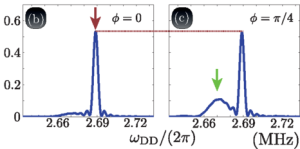
Pulse-phase control for spectral disambiguation in quantum sensing protocols
J. F. Haase, Z.-Y. Wang, J. Casanova, and M. B. Plenio
Phys. Rev. A 94, 032322 (2016)
DOI:https://doi.org/10.1103/PhysRevA.94.032322
Whenever a quantum device (e.g. the electron spin qubit of the NV center in diamond) is used as a sensor to measure parameters of interest, one needs to ensure that the collected data is interpreted correctly. In the case of remaining uncertainties, proper tools are required to eliminate them completely.
In this work, we address the emergence of spurious resonances in pulsed NMR sequences and develop a criterion to identify these fake signals. These resonances occur due to the specific design of the pulse sequences which itself are already meant to suppress errors, however the finite width of the pulses causes the accumulation of the undesired signals. The proposed criterion relays on the free choice of the initial phase relation of the equally weighted superposition of the sensing qubit’s energy eigenstates, which is generally used as the input state in sensing experiments. It turns out, that a variation of this phase relation causes an oscillating amplitude of spurious signals while real signals remain stable. Additionally, we find that the effect of a varying phase relation is equivalent to a variation in phase of the applied pulses, which qualifies the criterion for an easy implementation in existing experimental setups.
To gain a deep understanding of the criterion’s working principle, we motivate it with an approximated analytical calculation and verify its validity with an extensive numerical simulation.
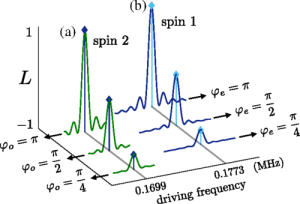
Noise-Resilient Quantum Computing with a Nitrogen-Vacancy Center and Nuclear Spins
J. Casanova, Z.-Y. Wang, and M. B. Plenio
Phys. Rev. Lett. 117, 130502 (2016)
DOI:https://doi.org/10.1103/PhysRevLett.117.130502
Solid-state platforms as diamond doped with nitrogen impurities present enormous advantages to hold a scalable quantum processor. These systems combine the presence of many stable quantum registers, i.e. nuclear spins, together with the possibility to coherently interact with them via a color impurity, e.g. and NV center implanted on the system, controlled with external radiation. In this work, we present a study of the effect in the hybrid system of an NV-center surrounded by nearby 13C atoms, each of them holding a stable qubit, of the minimal ingredients required for quantum computing. These are, robust sequences of microwave pulses applied on the NV-center, combined with the presence of radio frequency fields for both single qubit operations and internuclear decoupling. Our study finds an appropriate operating regime for the joined action of these tools, and reveals the presence of an experimentally friendly low-energy resonance branch for accurate quantum control of the nearby qubits.
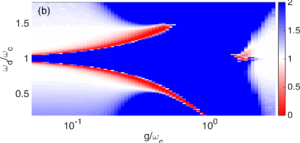
Fate of photon blockade in the deep strong-coupling regime
A. Le Boité, M.-J. Hwang, H. Nha and M.B. Plenio, Phys. Rev. A 94, 033827 (2016)
DOI:https://doi.org/10.1103/PhysRevA.94.033827
Experiments in cavity quantum electrodynamics (cavity QED), involving a strong interaction between an atom and a cavity photonic mode, have proved very powerful both for testing fundamental laws of quantum physics and implementing quantum information protocols. One important milestone was to reach an atom-cavity interaction larger than any dissipation rate. In this so-called “strong-coupling regime”, the coupling of light to matter induces effective photon-photon interactions which give rise to interesting nonlinear effects. One of the most famous is the photon blockade effect, where the presence of a single photon inside the cavity is sufficient to inhibit the absorption of another photon. A consequence of the photon blockade is that photons have a tendency to come out of the cavity one by one, which is a purely quantum effect.
The effective photon-photon interaction in a cavity QED system is well captured, in the strong coupling regime, by the Jaynes-Cummings (JC) model. Its energy spectrum has a nonlinear ladder structure responsible for the photon blockade. Furthermore, the JC model predicts that the nonlinearity of the energy spectrum increases with the coupling strength and that the photon-blockade effect gets more pronounced. We show in this paper that this is no longer true when the coupling strength is increased even further and becomes comparable or larger than the cavity frequency. In this regime, called the “ultrastrong-coupling regime”, the rotating-wave approximation on which the JC model is based is no longer valid and a description of the system based on the Rabi model is necessary.
Within this theoretical framework, we show that, as the atom-cavity coupling strength increases, the system undergoes multiple transitions in the photon statistics. In particular, a first breakdown of the photon blockade is shown to be the consequence of a parity shift in the energy spectrum. A subsequent revival of the photon blockade and the emergence of the quasi-coherent statistics, for even larger coupling rates, are attributed to an interplay between the nonlinearity in the energy spectrum and the transition rates between the eigenstates of the Rabi Hamiltonian.
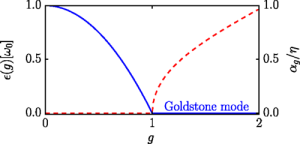
Quantum phase transition in the finite Jaynes-Cummings lattice systems
M.-J. Hwang and M.B. Plenio, Phys. Rev. Lett. 117, 123602 (2016)
DOI:https://doi.org/10.1103/PhysRevLett.117.123602
The Jaynes-Cummings (JC) model is one of the most important model in the field of quantum optics, which describes the interaction between a quantized light and an atom. Ever since the first introduction of the model early in 60s, this exactly solvable model has played a key role in understanding many beautiful quantum optical phenomena observed in the laboratory. This paper reveals yet another fascinating aspect of the JC model that has remained hidden in more than half a century of extensive studies. We demonstrated that the exact solution of the JC model exhibits all the hallmarks of the second-order quantum phase transition (QPT) with a broken continuous symmetry.
In an earlier work done at our institute Phys. Rev. Lett. 115, 180404 (2015), we have demonstrated that the Rabi model may undergo a QPT in a particular limit of large detuning and large coupling strength. This was the first example where the system far from the standard thermodynamic limit of infinite particles exhibits a QPT. Surprisingly, the QPT of the JC model, which has a different symmetry and different microscopic interaction from the Rabi model, occurs in the same limit. Furthermore, in this paper, we also demonstrate that the lattice extension of the JC model, the JC lattice model, also undergoes a QPT in the same limit even when the number of lattice sites is finite. Therefore the current paper together with the earlier work on the Rabi model demonstrates that the finite-system QPT is a generic phenomena of quantum mechanics not limited to a particular symmetry, microscopic interaction, and spatial dimension, suggests that they will be present in a broad range of physical systems, and establishes a general principle of realizing the finite-system QPT.
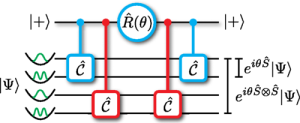
Universal Quantum Computing with Arbitrary Continuous-Variable Encoding
H.-K. Lau and M.B. Plenio, Phys. Rev. Lett. 117, 100501 (2016)
DOI:https://doi.org/10.1103/PhysRevLett.117.100501
When we build a quantum computer, the first thing we need to specify is the quantum states that represent the quantum bit (qubit) of information, 0 and 1. If the quantum system have energy eigenstates with specific properties, such as the electronic states of trapped ions and diamond NV centres, the qubit states can be two of the energy eigenstates, and we can control them one-by-one. On the other hand, there are quantum systems that behave like harmonic oscillators, e.g. atom ensembles and mechanical oscillators. These systems have infinitely many energy eigenstates, but it is difficult to single out two of them as a qubit. In the literature, quite a number of “encodings” have been proposed to represent a qubit by specially-chosen superpositions of multiple eigenstates. For examples, the qubit states could be vacuum and single photon states, or two coherent states with different amplitude, or two Schrodinger’s Cat states. Due to the difference of physical behaviours, each encoding is advantageous in some specific parts of quantum computation. However the difference of encoding also diversifies the architecture of quantum computers, because the quantum computer logic gates have to be implemented by the interaction that depends on the encoding.
In our work, we ask if exists a unified set of interaction that perform the logic gates for every encoding. Surprisingly, the answer is yes. Our idea is to represent the qubit by the parity of any two encoding states. We show that all quantum logic gates can be preformed by the newly found exponential-swap interaction. Because the interaction is the same, our method unifies the architecture of harmonic oscillator quantum computer. Our scheme also brings additional benefits that different computational parts could employ different encodings, and the quantum information can be protected from a typical class of noise: collective noise.
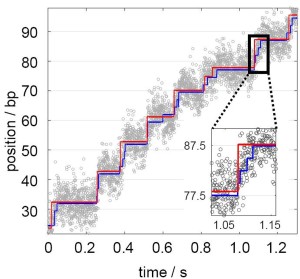
An Energy Based Scheme for Reconstruction of Piecewise Constant Signals observed in the Movement of Molecular Machines
J. Rosskopf, K. Paul-Yuan, M.B. Plenio and J. Michaelis
Phys. Rev. E 94, 022421 (2016)|ArXiv
DOI:https://doi.org/10.1103/PhysRevE.94.022421
Analyzing the physical and chemical properties of single DNA based molecular machines such as polymerases and helicases requires to track stepping motion on the length scale of base pairs. Although high resolution instruments have been developed that are capable of reaching that limit, individual steps are oftentimes hidden by experimental noise which complicates data processing. Here, we present an effective two-step algorithm which detects steps in a high bandwidth signal by minimizing an energy based model (Energy based step-finder, EBS).
First, an efficient convex denoising scheme is applied which allows compression to tuples of amplitudes and plateau lengths. Second, a combinatorial clustering algorithm formulated on a graph is used to assign steps to the tuple data while accounting for prior information. Performance of the algorithm was tested on poissonian stepping data simulated based on published kinetics data of RNA Polymerase II (Pol II). Comparison to existing step-finding methods shows that EBS is superior in speed while providing competitive step detection results especially in challenging situations. Moreover, the capability to detect backtracked intervals in experimental data of Pol II as well as to detect stepping behavior of the Phi29 DNA packaging motor is demonstrated.

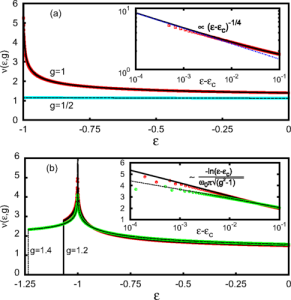
Excited-state quantum phase transition in the Rabi model
R. Puebla, M.-J. Hwang and M.B. Plenio
Phys. Rev. A 94, 023835 (2016)
DOI:https://doi.org/10.1103/PhysRevA.94.023835
A two-level system coupled to a single harmonic oscillator, which is known as Rabi model, can undergo a quantum phase transition. This phase transition takes place when the ratio between the two-level transition frequency is much larger than the oscillator frequency and in the regime of a very strong coupling strength, as shown in M.-J. Hwang et al, Phys. Rev. Lett. 115, 180404 (2015). Here, we show that the quantum phase transition accompanies critical behavior in higher energy excited states, known as excited-state quantum phase transition. The main hallmark of excited-state quantum phase transitions consists in a singular density of states at a critical excitation energy rather than at a critical value of an external control parameter. With help of a semiclassical approach, we find analytically the density of states, which diverges logarithmically as the excitation energy approaches to its critical value. Additionally, relevant observables, such as boson number or two-level polarization, display singularities as a consequence of the diverging density of states at the critical excitation energy.
This work shows that excited-state quantum phase transitions can be realized in a simple quantum system, as it is a single two-level system interacting with a single bosonic field, without resorting to the thermodynamic limit, i.e. the traditional limit of infinitely many system components.
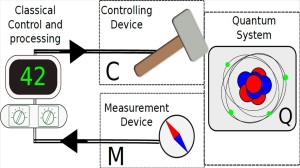
Coherent control of quantum systems as a resource theory
J.M. Matera, D. Egloff, N. Killoran, and M.B. Plenio
Quantum Sci. Technol. 1, 01LT01 (2016)|ArXiv
While controlling a quantum system is a standard task nowadays, we are still far away from developing quantum computers, and one might wonder what is the difference between the two. Qualitatively the difference is that for quantum computing one needs to control quantum systems in a quantum way, using quantum systems instead of directly using the large apparata or (classical) electromagnetical fields that often are enough to control a quantum system directly. In this letter we make this idea precise by building a theory which allows us to quantify the usefulness of controlling a quantum system through a quantum system instead of using a classical one.
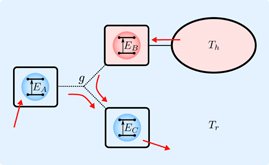
Realising a quantum absorption refrigerator with an atom-cavity system
M. Mitchison, M. Huber, J. Prior, M.P. Woods and M.B. Plenio
Quantum Sci. Technol. 1, 015001 (2016)|ArXiv
licensed under CC BY 3.0
Cooling of atomic motion is an essential precursor for many interesting experiments and technologies, such as quantum computing and simulation using trapped atoms and ions. In most cases, this cooling is performed using lasers to create a kind of light-induced friction force which slows the atoms down. This process is often rather wasteful, because lasers use up a huge amount of energy relative to the tiny size of the atoms we want to cool. Here, we propose to solve this problem using a quantum absorption refrigerator: a machine that is powered only by readily available thermal energy, such as sunlight, as it flows through the device. We describe how to build such a refrigerator, and predict that sunlight could actually be used to cool an atom to nearly absolute zero temperature. The refrigerator works by trapping the sunlight between two mirrors, in such a way that every single photon makes a significant contribution to the friction force slowing the atom down. Similar schemes could eventually be important for reducing the energy cost of cooling in future quantum technologies.
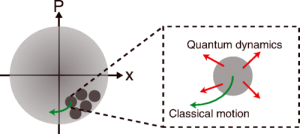
Laser cooling of a high-temperature oscillator by a three-level system
H.-K. Lau and M.B. Plenio,
Phys. Rev. B. 94, 054305 (2016)
DOI:https://doi.org/10.1103/PhysRevB.94.054305
To observe the quantum effect, we usually need to cool an object to nearly the ground state. If the object is interacting with a two-level system that is dissipative, then we can apply laser cooling. Although different kinds of object, ranging from singly trapped atom to visibly large mechanical oscillator, have been successfully cooled by laser cooling, it is believed to be efficient only under demanding conditions. One such condition is that the background temperature is sufficiently low that satisfies the so-called Lamb-Dicke regime. Surprisingly, it was recently found that laser cooling is sometimes possible even when the background temperature is higher than the Lamb-Dicke regime. In our work, we study this phenomenon more closely. We start from developing a technique to separate the classical part from the quantum part of the dynamics of the object, so the system is easier to study. Then we extend previous analysis to three-level systems, which are more easily found in the real world. We confirm previous observation of high temperature laser cooling, and provide a modified criterion to judge when laser cooling is efficient. Surprisingly, we also find some situations that laser cooling can cool the object only for a limited time, after that the object would be heat up significantly.
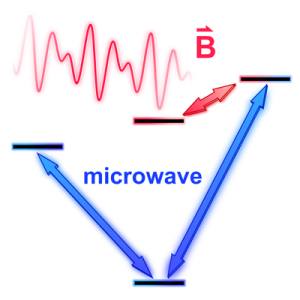
Ultrasensitive magnetometer using a single atom
I. Baumgart, J.M. Cai, A. Retzker, M.B. Plenio and Ch. Wunderlich,
Phys. Rev. Lett. 116, 240801 (2016)
DOI:https://doi.org/10.1103/PhysRevLett.116.240801
The development of highly sensitive methods for the detection of minute fields lies at the heart of quantum metrology and has, over the history of science, led to many discoveries. This motivates the continuous drive towards the development of ever more sensitive metrology methods. Of particular interest in this context are atoms and ions that are trapped in ultra-high vacuum as they can be isolated to a remarkable degree from environmental influences. Still noise will impose limitations and needs to be addressed.
We demonstrate a novel method for sensing magnetic fields and demonstrate that it can achieve the best sensitivity ever realized for a single trapped atomic particle and it can do so over a broad range of frequencies. State-of-the-art magnetometers reach their best sensitivity in a limited frequency-band or do not work at all (for all practical purposes) outside a certain frequency range. The type of magnetometer introduced here could be used to detect fields from direct-current to the gigahertz regime – an unprecedented range of frequencies – using an atom confined to a nanometer-sized region in space. Moreover, the magnetometer is essentially immune against magnetic disturbances and reaches a sensitivity close to the standard quantum limit.
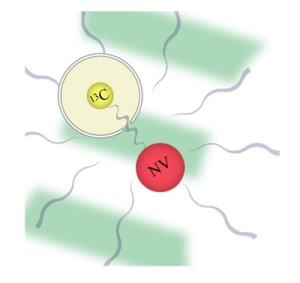
Quantum metrology enhanced by repetitive quantum error correction
Th. Unden, P. Balasubramanian, D. Louzon, Y. Vinkler, M.B. Plenio M. Markham, D. Twitchen, I. Lovchinsky, A.O. Lovchinsky, M.D. Lukin, A. Retzker, B. Naydenov, L. McGuinness and F. Jelezko,
Phys. Rev. Lett. 116, 230502 (2016)
DOI:https://doi.org/10.1103/PhysRevLett.116.230502
In sensing and metrology noise is a fundamental problem because it randomises the sensor and therefore limits its precision. Quantum information science has found different ways to reduce the impact of noise and one of these is quantum error correction. Typically, quantum error correction requires a significant overhead in qubits, one needs at least three qubits to encode and protect a single qubit against phase noise. But this overhead can be reduced when combining stable qubits for encoding with error prone qubits for sensing. This has been achieved experimentally in our recent work where a sensing electron spin is combined with a encoding nuclear spin and repeated error correction has been achieved in combination with sensing.
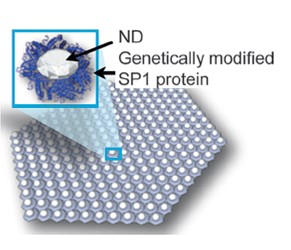
Diamond Quantum Devices in Biology
Y. Wu, F. Jelezko, M.B. Plenio and T. Weil
Angewandte Chemie – International Edition Minireview 55, 6586 – 6598 (2016)
The Institute of Theoretical Physics is Corresponding PI of the ERC Synergy Grant BioQ “Diamond Quantum Devices and Biology” which is looking in the development of quantum technologies for studying biology, the impact of quantum dynamics on biological function and the use of self-organised structures for creating quantum devices. This invited minireview is summarizing recent developments in the first and the third topic (for a review on the second topic see Contemp. Phys. 54, 181 (2013)).
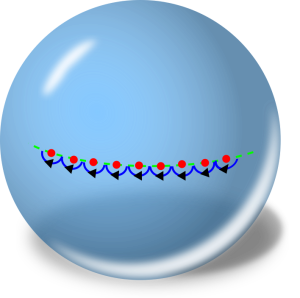
Necessary and sufficient condition for quantum adiabatic evolution by unitary control fields
Z.-Y. Wang, M.B. Plenio,
Phys. Rev. A 93, 052107 (2016)
DOI:https://doi.org/10.1103/PhysRevA.93.052107
This work derives the necessary and sufficient condition for quantum adiabatic evolution, that is, when a system remains in an eigenstate of a Hamiltonian even if this Hamiltonian changes over time. It settles a problem that had been identified in the conditions for adiabatic quantum evolution that had been formulated over the last 50 years or so. With the finding that the widely used quantum adiabatic quantitative condition is not always valid, various new necessary or sufficient adiabatic conditions were proposed for replacing the traditional one. However, none of these conditions has been successfully shown to be both necessary and sufficient. Our work settles the problem by providing a simple condition with proofs for both its necessity and sufficiency, by using a gauge invariant formalism to extract all the nonadiabatic transitions. Counterintuitively, the condition reveals that quantum adiabatic evolution allows rapid changes and/or arbitrary numbers of energy crossings in the system Hamiltonian. New ways to achieve quantum adiabatic evolution by pulse sequences or fast varying fields are demonstrated.
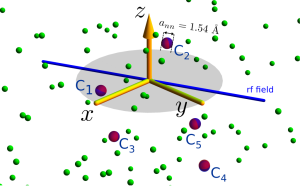
Positioning nuclear spins in interacting clusters for quantum technologies and bioimaging
Z.-Y. Wang, J. F. Haase, J. Casanova, and M. B. Plenio,
Phys. Rev. B 93, 174104 (2016)
DOI:https://doi.org/10.1103/PhysRevB.93.174104
In this paper we present a method to detect, locate, and control individual nuclei in interacting clusters by using a single nitrogen-vacancy (NV) center and external control provided by microwave and radio-frequency radiation. The method overcomes the inability of previous schemes to address individually spins that are interacting. It also does not suffer from serious technical drawbacks related to the reorientation of the external alignment field, which affects the NV readout and initialization and is time consuming in current laboratory setups. Detailed numerical simulations demonstrate the precision that our method can achieve by resolving 3D structures of nuclear spins in complex ensembles with Angstrom fidelity. With this information at hand, different applications that include quantum information processing using clusters of carbon-13 nuclei in diamond or identification of the stereoisomeric forms of molecules are available. Note that the former paves the way to exploit the exceptional properties of nuclear spins as solid-state quantum registers while, the latter, corresponds to a question that could previously be answered only when billions of these molecules were available.
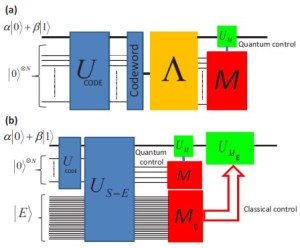
Sensing in the presence of observed environments
M.B. Plenio and S.F. Huelga,
Phys. Rev. A 93, 032123 (2016)
DOI:https://doi.org/10.1103/PhysRevA.93.032123
Sensing and metrology in the presence of environmental noise represents a considerable challenge because the noise limits the observation time and hence the achievable precision. In this work we explore the idea what may happen when we have limited access to the environment, e.g. we can measure whether the sensor has spontaneously emitted a photon. This information alone may improve the achievable precision quite considerably and the present work shows this at the hand of some examples.
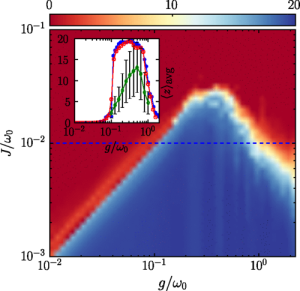
Recurrent Delocalization and Quasiequilibration of Photons in Coupled Systems in Circuit Quantum Electrodynamics
Myung-Joong Hwang, M. S. Kim, and Mahn-Soo Choi,
Phys. Rev. Lett. 116, 153601 (2016)
DOI:https://doi.org/10.1103/PhysRevLett.116.153601
Charged particles can interact with each other, or feel the presence of other charged particles, through the Coulomb interaction. While such an interaction mechanism does not naturally exist for photons, it is well-known that a single atom placed inside of a cavity can mediate an interaction among photons inside of the cavity. The magnitude of this induced photon-photon interaction is often thought to monotonically increase as a function of the atom-photon interaction strength. Contrary to this belief, we show in our work that beyond a certain threshold value, the stronger atom-photon interaction starts to reduce the induced photon-photon interaction. This rather counter-intuitive property of the induced photon-photon interaction is discussed in the context of the photon population dynamics in a coupled cavity array where there occurs a double dynamical transition from a delocalization to localization, back to delocalization, of the photon population. Moreover, it is found that the second delocalization dynamics shows a quasi-equilibration despite of being a closed, finite quantum system.
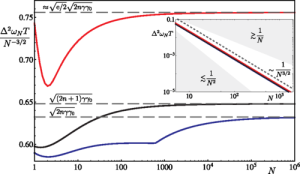
Ultimate precision limits for noisy frequency estimation
A. Smirne, J. Kołodynski, S.F. Huelga and R. Demkowicz-Dobrzanski,
Phys. Rev. Lett. 116, 120801 (2016)
DOI:https://doi.org/10.1103/PhysRevLett.116.120801
How precisely can we estimate the value of an unknown parameter? In classical experiments involving N sensing particles, i.e. N probes, the best estimation strategies lead to an error (as measured by the variance), which scales at most as 1/N, according to the central limit theorem. On the other hand, the use of entangled states can yield a further factor 1/N of improvement, which shows in a paradigmatic way that quantum features can be exploited to get a significant advantage compared to any classical strategy. Such a quantum advantage is nevertheless jeopardized by the interaction of the probing system with the surrounding environment. Previous results showed that the quantum and classical strategies become completely equivalent in the presence of random fluctuations of the parameter to be estimated, due to the influence of a fast-decaying environment.
In this work, we show how the advantage provided by using entangled states can be (partially) re-established, if one deals with a more general and more realistic type of system-environment interactions. Classical strategies can be outperformed if the probes are measured on time-scales short enough, in order to access the universal dynamical regime of open systems, where the survival probabilities decay less than linearly with time. In particular, we derive a lower bound to the estimation error, which holds for a wide and well-defined type of dynamics and we show its attainability, as well as pointing out the crucial dynamical features, which discriminate between classical or super-classical limits to the parameter estimation.
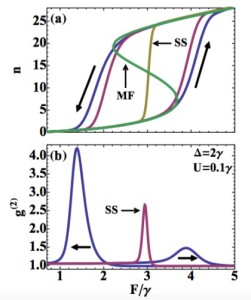
Power laws in the dynamic hysteresis of quantum nonlinear photonic resonators
W. Casteels, F. Storme, A. Le Boité, and C. Ciuti,
Phys. Rev. A 93, 033824 (2016)
DOI:https://doi.org/10.1103/PhysRevA.93.033824
In a wide class of systems, sweeping back and forth the driving amplitude of a nonlinear resonator produces a hysteresis cycle, which for electromagnetic resonators is referred to as optical bistability. For weak nonlinearities, it can be described by a semiclassical approach neglecting quantum fluctuations. It is known that quantum fluctuations induce switching between two classically stable branches. The steady-state is then unique and consists of a statistical mixture of the two branches. in other words, in the quantum regime (for large nonlinearities), there is no static hysteresis.
We show in this work that there is nonetheless a dynamic hysteresis in the quantum regime. By sweeping the driving amplitude in a finite time we show that the area of the hysteresis cycle exhibits a rich temporal power-law behavior, qualitatively different from semiclassical predictions. We connect this behavior to a nonadiabatic response of the system and establish a link with the Kibble-Zurek mechanism for quenched phase transitions.
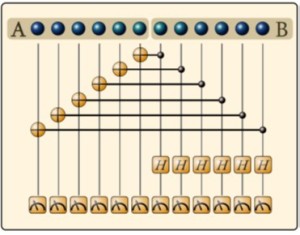
Practical Entanglement Estimation for Spin-System Quantum Simulators
O. Marty, M. Cramer and M.B. Plenio,
Phys. Rev. Lett. 116, 105301 (2016)
DOI:https://doi.org/10.1103/PhysRevLett.116.105301
Strong entanglement, a quintessential feature of quantum mechanics, is typically a signature of a successfully implemented quantum simulator. Indeed, the aim of these experiments is the preparation and control of systems which show genuine quantum features. For example, recent experiments with trapped ions were designed to implement critical systems – a scenario which is known to become hard to simulate numerically with increasing number of spins due to the presence of large quantum correlations. In order to determine the entanglement in an experiment, one has to take into account that measurements to extract the required information are not only limited by the specifications of the different experimental platforms but, more generally, also by the large dimension of the Hilbert space. A familiar choice to overcome these issues are entanglement witnesses. In our work we determine entanglement witnesses that are quantitative in the sense that they determine lower bounds to the logarithmic negativity, a widely used entanglement measure, that can be obtained to reveal the behavior of entanglement across quantum phase transitions experimentally. In particular, we describe how these witnesses can be measured, e.g., using a short sequence of gate operations and we study the robustness of these measurements in the presence of noise.
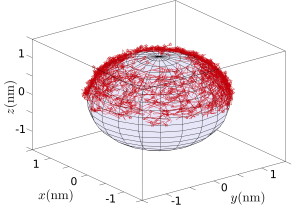
Sensing of single nuclear spins in random thermal motion with proximate nitrogen-vacancy centers
M. Bruderer, P. Fernández-Acebal, R. Aurich and M. B. Plenio,
Phys. Rev. B 93, 115116 (2016)
DOI:https://doi.org/10.1103/PhysRevB.93.115116
The electronic spin of nitrogen-vacancy (NV) centers in diamond is extremely sensitive to local magnetic fields, which makes them a valuable tool for sensing nuclear and electronic spins in their vicinity. While the detected spin targets are static in most applications, the situation is entirely different for ambient thermal conditions as encountered, for example, in biological environments. In this case, the spin-carrying molecules and thus the spins undergo random diffusive motion. In our work we simulate the motion of diffusive spins for specific molecules and derive effective models for the interaction between NV centers and spin targets. We find in particular that spins undergoing rapid diffusion in a restricted domain behave as “averaged” spins, which can still be detected under realistic experimental conditions.

Universality in the Dynamics of Second-Order Phase Transitions
G. Nikoghosyan, R. Nigmatullin and M.B. Plenio,
Phys. Rev. Lett. 116, 080601 (2016)|ArXiv
DOI:https://doi.org/10.1103/PhysRevLett.116.080601
Symmetry breaking phase transitions and their dynamics are at the heart of a broad range of physical phenomena ranging from the physics of the early universe to solid state physics. Of particular interest are dynamical properties when traversing such a symmetry-breaking second-order phase transition at a finite rate as then spatially separated parts of the system may chose symmetry-broken phases independently and where such choices are incompatible, topological defects form whose number dependence on the quench rate is given by simple power laws.
Typically these powerlaws are derived by physical arguments which works well in simple cases but can lead to wrong conclusions in complex situations involving for example spatial inhomogeneities. We propose a general approach for the derivation of such scaling laws that is based on the analytical transformation of the associated equations of motion to a universal form rather than employing plausible physical arguments. We demonstrate the power of this approach by deriving the scaling of the number of topological defects in both homogeneous and nonhomogeneous settings.
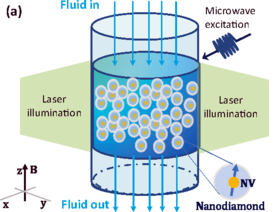
Resonance-inclined optical nuclear polarization of liquids in diamond structures
Q. Chen, I. Schwarz, F. Jelezko, A. Retzker and M.B. Plenio,
Phys. Rev. B 93, 060408(R) (2016)
DOI:https://doi.org/10.1103/PhysRevB.93.060408
Nuclear spin hyperpolarization (DNP) is a key emerging method for increasing the sensitivity of nuclear magnetic resonance (NMR). Using DNP, a wide range of novel applications in biomedical sciences is made possible, such as metabolic MR imaging or the characterization of molecular chemical compositions. The prevalent methods for achieving DNP in solutions are typically most effective in the regime of small interaction correlation times between the electron and nuclear spins, limiting the size of accessible molecules. To solve this limitation, we design a mechanism for DNP in the liquid phase that is applicable for large interaction correlation times (e.g. slow-moving molecules). We combine this scheme with optically polarized nitrogen-vacancy (NV) center spins in diamonds which provides near perfect electron polarization source at room temperature. Considering the model in a flow cell containing nanodiamonds immobilized in a hydrogel, numerical illustration shows flowing water molecules can be polarized over 1000-fold, in sufficient volumes for detection by current NMR scanners.
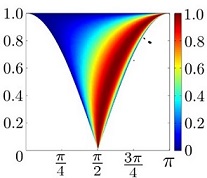
Converting non-classicality into entanglement
N. Killoran, F.E.S. Steinhoff and M.B. Plenio,
Phys. Rev. Lett. 116, 080402 (2016)
DOI:https://doi.org/10.1103/PhysRevLett.116.080402
There is a longstanding discussion about the question where exactly the border between the classical and the quantum world might lie and depends very much on which features of the world we define as non-classical in the first place. Entanglement is one of the few features that we tend to agree upon as being non-classical. Hence we decided to attack the question of non-classicality from the viewpoint of entanglement by examining which states can be interconverted into entangled states. The results that we obtain generalize and link convertibility properties from the resource theory of coherence, spin coherent states, and optical coherent states, while also revealing important connections between local and nonlocal pictures of non-classicality.
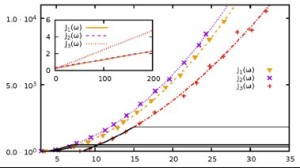
Efficient simulation of non-Markovian system-environment interaction
R. Rosenbach, J. Cerrillo, S.F. Huelga, J.S. Cao and M. B. Plenio,
New J. Phys. 18, 023035 (2016)|ArXiv
licensed under CC BY 3.0
The numerical simulation of the interaction of electronic degrees of freedom with their environment is highly challenging when we want to know precise answers and when the environment has a complicated structure so that the evolution cannot be approximated by master equations. This is just the regime in which biological excitation energy transfer in photosynthetic complexes is taking place. In our group we had developed earlier the TEDOPA method while Javier Cerrillo, a former PhD student in the group, had developed another approach, the memory kernel method. During a visit at MIT and a return visit at Ulm we decided to merge the two methods to combine their strengths and the present paper is the result.
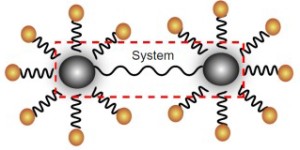
Dynamical error bounds for continuum discretization via Gauss quadrature rules – a Lieb-Robinson bound approach
M.P. Woods and M.B. Plenio,
J. Math. Phys. 57, 022105 (2016)|ArXiv
The interaction of a quantum system with its environment is of fundamental importance for the development of quantum technologies. The spin-boson model in which a spin degree of freedom couples to a continuum of harmonic oscillators is one of the most fundamental models in this area. A continuum of harmonic oscillators is not easy to treat numerically and ideally one would like to reduce them to a finite number of harmonic oscillators, i.e. to discretize the harmonic environment. This will make us to commit errors that we need to bound. Our work uses a chain mapping that we had developed earlier together with Lieb-Robinson type methods which limit the speed at which perturbation travel through such chains to develop such error bounds.
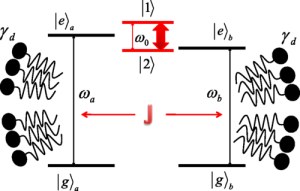
Phase-dependent exciton transport and non-equilibrium energy harvesting from thermal environments
S. Oviedo, J. Prior, A.W. Chin, R. Rosenbach, S.F. Huelga and M.B. Plenio,
Physical Review A 93, 020102(R) (2016)
DOI:https://doi.org/10.1103/PhysRevA.93.020102
When a physical system in an excited state is coupled to a cold environment, typically the direction of energy flow is from “hot” system to “cold” environment. This situation changes when the environment is non-Markovian, that is, when its spectral distribution is not flat and when the system exhibits quantum coherence. In this work we show that under these circumstance uphill energy transport is possible, i.e. for the system to absorb energy temporarily from the colder environment thus violating detailed balance.
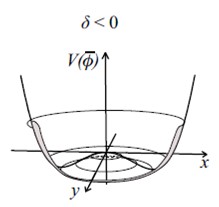
Formation of helical ion chains
R. Nigmatullin, A. del Campo, G. De Chiara, G. Morigi, M.B. Plenio and A. Retzker,
Physical Review B 93, 014106 (2016)
DOI:https://doi.org/10.1103/PhysRevB.93.014106
Symmetry breaking phase transitions and their dynamics are at the heart of a broad range of physical phenomena ranging from the physics of the early universe to solid state physics. Of particular interest are dynamical properties when traversing such a symmetry-breaking second-order phase transition at a finite rate as then spatially separated parts of the system may chose symmetry-broken phases independently and where such choices are incompatible, defects form whose number dependence on the quench rate is given by simple power laws.
Here we study the dynamics of symmetry breaking phase transitions in the formation of helical ion strings that are being held in ion traps that are rotationally invariant around one trap axis. The structures that can occur can be visualised by taking a belt from your trouser and holding it front of you with both hands. Turning one end of the belt creates a helical structure with a winding number that depends on the number of turns. When you go through a phase transition in which the planar structure becomes unstable, we will end up with a finite winding number depending on how fast we traverse the phase transition. We derive analytical scaling laws and confirm them with extensive numerical simulations.
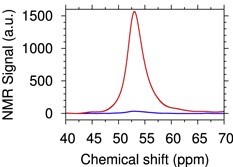
Optically induced dynamics nuclear spin polarization in diamond
J. Scheuer, I. Schwarz, Q. Chen, D. Schulze-Sünninghausen, P. Carl, P. Höfer, A. Retzker, H. Sumiya, J. Isoya, B. Luy, M.B. Plenio, B. Naydenov, and F. Jelezko
New Journal of Physics 18, 013040 (2016)|ArXiv
Magnetic resonance imaging (MRI) detects the tiny magnetic moment generated by the nuclear spin of hydrogen atoms in your body. Its sensitivity depends strongly on nuclear spin polarisation, i.e. the magnetisation of the body. Motivated by this observation, dynamical nuclear spin polarisation (DNP), the transfer of electron spin polarization to nuclear spins, has recently been applied to enhance MRI signal. Typically, large signal enhancements (hyperpolarization) require cryogenic temperatures (< 2 K) and bulky, specialized equipment for achieving first a high electron polarization. The Nitrogen-Vacancy defect (NV centre) in diamonds and diamond nanocrystals (nanodiamonds) provides a unique alternative for DNP as the NV centre electron spin can be optically polarized to over 90% polarization at room temperature by short laser pulses.
In our paper we demonstrate an efficient scheme that realises laser induced 13C nuclear spin hyperpolarization in a bulk diamond at room temperature and low ambient magnetic field. Importantly, our protocol is robust against an unknown alignment of the diamond crystal, making this a viable protocol for optical polarization of solutions of nanodiamond. This result gives rise to the possibility of using nanodiamonds, suitably treated to attach themselves to targets that we would like to detect, as MRI markers for molecular imaging applications.
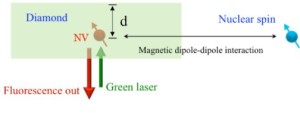
Dynamical nuclear polarization using multi-colour control of color centers in diamond
P. Yang, M.B. Plenio and J.M. Cai
EPJ Quantum Technology 3, 1 (2016)
Using laser light it is possible to polarize the electron spin of a colour center in diamond even at room temperature. Resonant microwave radiation can then be used to transfer this polarization to surrounding nuclear spins. Repeating this procedure many times over can lead to very strongly (hyper)-polarized nano-diamonds that may be useful as a contrast agent in MRI. One of the challenges is the random orientation of nanodiamonds in a solution which makes it difficult to achieve resonance with microwaves. In this work we explore the use of microwave frequency combs, i.e. the use of many microwave frequencies to achieve better performance.
Contact


Ulm University
Institute of Theoretical Physics
Albert-Einstein-Allee 11
D - 89081 Ulm
Germany
Tel: +49 731 50 22911
Fax: +49 731 50 22924
Office: Building M26, room 4117
Click here if you are interested in joining the group.
Most Recent Papers
Efficient Information Retrieval for Sensing via Continuous Measurement, Phys. Rev. X 13, 031012, arXiv:2209.08777
Active hyperpolarization of the nuclear spin lattice: Application to hexagonal boron nitride color centers, Phys. Rev. B 107, 214307, arXiv:2010.03334
Driving force and nonequilibrium vibronic dynamics in charge separation of strongly bound electron–hole pairs, Commun Phys 6, 65 (2023), arXiv:2205.06623
Asymptotic State Transformations of Continuous Variable Resources, Commun. Math. Phys. 398, 291–351 (2023), arXiv:2010.00044
Spin-Dependent Momentum Conservation of Electron-Phonon Scattering in Chirality-Induced Spin Selectivity, J. Phys. Chem. Lett. 2023, 14, XXX, 340–346, arXiv:2209.05323
